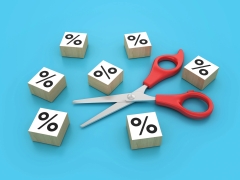
The Bank of England has cut UK interest rates to 4.25% and this has a major impact on personal finances. It is the lowest level for rates in two years.
The cut is good news for anyone looking to buy a house or flat as mortgage rates should come down, although many rates have already fallen in anticipation of Bank of England base rate cuts.
Investors typically welcome interest rate cuts as they make it cheaper for companies and consumers to borrow money – potentially leading to higher spending and greater economic activity. That driver often feeds into higher share prices, but there is no guarantee that will happen each time.
It’s bad news for savers as interest rates are likely to come down on variable-rate savings accounts.
Why have interest rates been cut?
Lower than expected inflation has played a big role in the Bank of England deciding to cut interest rates. Households should have benefited from lower oil and gas prices, and from the likely diversion of cheap goods imports from Asia to the UK. Inflation is expected to go up in the near-term, but not by as much as the Bank of England previously expected.
The Bank now expects the CPI rate of inflation to peak at 3.5% later this year, down from its previous forecast of 3.75%. It believes the rise in inflation will be temporary, but it’s worth noting it also believed transitory inflation would dissipate in 2022, before it then turned into the cost-of-living crisis.
The Bank believes tariffs will dampen prices in the UK, rather than increase them, and there are some warning signs in the forecasts of what may be to come. In particular, economic growth expectations have been pared back, and UK unemployment is now forecast to hit 5% at the back end of 2026.
Could we see further rate cuts this year?
A generous pinch of salt is required when digesting the Bank’s forecasts. They are based on the 90-day pause on reciprocal tariffs being maintained by the US indefinitely. The true end-state of US trade policy may look very different, and could slide in any plausible direction, or indeed one which has not yet been countenanced. Economic reality may turn out to be very different to the Bank’s forecasts, for better, or worse.
For that reason, it’s best not to bet the house on interest rates being cut to 3.5% by the end of this year. That’s what the market currently expects, and based on the Bank’s forecasts would serve to bring inflation back to 2% in the medium term.
With such a high degree of uncertainty around the forecasts, it would be unwise to ink three more rate cuts in this year. Indeed, the latest trade deal between the US and the UK has rendered the Bank’s forecasts obsolete by the end of the day they were published.
How did the market react to the interest rate cuts?
The market did not immediately react in the way you might expect to an interest rate cut. The yield on the 2-year gilt rose from 3.8% to 3.88%. Yields rise when prices fall.
This reaction probably reflects the fact a rate cut was already priced in, but a split vote in which two members of the Bank’s committee voted to keep rates on hold was not.
The split vote meant the market saw this as a hawkish interest rate cut, even though two members of the committee wanted to go further and cut rates to 4%. The three-way split is no doubt a result of the economic uncertainty stemming from global trade ructions creating a diversity of opinion on the best path for monetary policy.
What could happen next with rates on mortgages and savings?
Swap rates, on which fixed term mortgages are priced, rose a touch on the back of the announcement, probably due to the split vote too. That may well put a cork in the flurry of mortgage rate cuts we have seen in recent weeks, though some lenders may still have cuts in the pipeline yet to be announced.
Variable rate mortgages can still be expected to fall. Trump’s tariffs have led to falling fixed mortgage rates so far, but whether that continues to be the case depends on the final implementation, and the reaction of interest rate markets. Unfortunately for mortgage borrowers, guessing the future direction of the mortgage market right now is like a high stakes game of blind man’s buff.
Cash savers will also note that interest rates and the inflation rate are converging. That means variable rate accounts will start to be pinched in terms of providing a real return, if only in the short term, assuming the Bank’s assessment that inflation is temporary proves to be correct.
At the most competitive end of the market, there are still savings accounts offering rates well above the rate of inflation, though that may not be the case once tax is considered. Hence why some cash savers have switched to the low coupon gilt market where returns can be harvested largely tax-free.
The less competitive end of the savings market is not so well insulated from rising inflation. The average easy access savings account pays 2.5%, according to Bank of England data. That means many savers don’t have a huge buffer against inflation, even before taking tax into account. And for some, their money will already be going backwards in real terms.
Ways to help you invest your money
Put your money to work with our range of investment accounts. Choose from ISAs, pensions, and more.
Let us give you a hand choosing investments. From managed funds to favourite picks, we’re here to help.
Our investment experts share their knowledge on how to keep your money working hard.
Related content
- Tue, 06/05/2025 - 16:16
- Thu, 01/05/2025 - 10:57
- Tue, 29/04/2025 - 09:23
- Wed, 23/04/2025 - 15:04
- Tue, 22/04/2025 - 13:58

